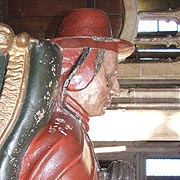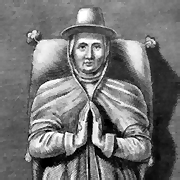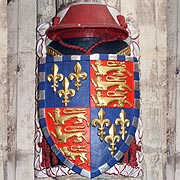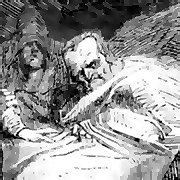
Cardinal Henry Beaufort (1375-1447) - Bishop
of Winchester 1404-1447
 |

|

|

|
Henry Beaufort was the grandson of King Edward III, being second son of John of Gaunt, Duke of Lancaster, by his mistress, Catherine Roet, the wife of Sir Hugh Swynford. He was born at Beaufort Castle in Anjou (France) around 1374, hence his surname. Henry's parents were eventually married some sixteen years later but, though his cousin, King Richard II, declared the four children of the union to be legitimate, they were barred from the Royal succession.
Henry entered the church and was consecrated Bishop of Lincoln in 1398, when he was only twenty-four. With his half-brother seizing the throne as King Henry IV, Beaufort was appointed Chancellor of England in 1403, but resigned a year later upon being transferred to the See of Winchester. Here, he succeeded William of Wykeham as Bishop and began to exercise considerable influence over the Prince of Wales (later Henry V). Beaufort always remained a steady supporter of the House of Lancaster, but his opposition to Thomas Arundel, Archbishop of Canterbury, and his party led to conflict with the Government. A dispute over the estate of Henry Beaufort's elder brother, the Marquis of Dorset, widened the breach between the two factions and, when, in 1411, the Prince of Wales suggested that his father abdicate in his favour, both he and Henry were dismissed from the Royal Council.
The Bishop of Winchester's disgrace lasted only two years, until Henry IV's death. When Henry V mounted the throne in 1413, Beaufort was made Chancellor again and ruled supreme in the Government while the King invaded France and attempted to restore the old Angevin Empire. Henry eventually resigned in 1417. He immediately proceeded to the Council at Constance and used his influence to effect a compromise between the rival factions. Grateful for Henry's services, the new Pope, Martin V, offered him the Cardinal's Hat; but Henry V refused to allow him to accept it. However, the King died in 1422, shortly after having claimed his place as heir to the throne of France.
Upon the succession of the infant Henry VI, the Bishop returned to the Council again where he became the chief opponent of the new monarch's uncle, Humphrey, Duke of Gloucester, and his wild and selfish schemes. He was appointed Chancellor for a third time in 1424 and was responsible for the conduct of affairs during Gloucester's expedition to Hainault to try and claim his wife's inheritance. Upon his return, Henry, naturally, reproached the Duke for the folly of his actions which had put the delicate English alliance with the Burgundians in jeopardy. This led to a riot in London, where the Bishop was not popular, and Henry found himself forced to recall, from France, Gloucester's brother, John, Duke of Bedford, as the official Protector of England. Bedford attempted to arbitrate between the two rivals at the Parliament which met at Leicester in February 1426, but Gloucester charged Henry with treason. Though he successfully denied the charges and despite an official reconciliation, the Bishop was eventually obliged to resign as Chancellor.
Meanwhile, Pope Martin was eager to secure the Bishop of Winchester's support for his Crusade against the Hussites and offered Henry the Cardinal's Hat once more. This time, he accepted. Cardinal Beaufort travelled to France in 1427 where he was made Papal Legate for Germany, Hungary and Bohemia. Moving eastward, he made a bold, though futile, attempt to rally the crusading troops at Tachau.
Back in England, raising money for a renewed crusade, the Cardinal was received with great pomp in London. However, his new ecclesiastical position had weakened his place in the Government and Gloucester refused to recognise him as Papal Legate. Henry did not push the matter, but his opponents did not relent and, in 1429, there was a concerted, though unsuccessful, effort to deprive him of his bishopric. Henry raised a large number of troops to set out for Bohemia but, with the imminent end to his legateship, he was persuaded to send them to France to relieve the recent English disasters of the Hundred Years War. The Cardinal himself accompanied Henry VI across the Channel in April 1430 and, on 16th December the following year, he crowned him as King of France at the Cathedral of Notre Dame in Paris.
Gloucester again attempted to deprive Henry of the See of Winchester, during his absence. He argued, in Council, that a Cardinal could not hold an English Bishopric. Though the General Council was inclined to drop the matter, the hostile Privy Council issued writs of praemunire and attachment against the Cardinal and seized some of his jewels. Beaufort soon returned to England and demanded to hear the charges against him at a Parliament held in May 1432. The King declared him a loyal subject and passed a statute freeing the Cardinal from all penalties he might have incurred.
Henry supported the Duke of Bedford in his attempts to restore order to the country's finances and, in August 1435, he attended the disastrous Congress of Arras which failed to make peace with France and brought to an end the English alliance with Burgundy. The Cardinal continued to pursue peace after Bedford's death, but was constantly opposed by his old enemy, Gloucester who wished the war to continue. Twice the Council advised the King to confine Henry to the shores of England, but, in 1437, he received a full pardon for any suppose offences. Two years later, he left for France on a peace mission and again the following year. Under the Cardinal's influence, the Council released the captured Charles, Duke of Orleans: a step which further irritated the Duke of Gloucester and pushed him into drawing up a long list of serious charges against Henry. The Council backed the latter's policies though and ignored Gloucester's personal accusations.
Still, it was time for the ageing Cardinal to begin to retire from public life. He continued to follow events however and survived long enough to see Suffolk bring about the marriage of Henry VI to Princess Margaret of Anjou in 1445. He finally died at Wolvesey Bishop's Palace in Winchester on 11th April 1447 and was buried in a fine chantry chapel in the Retrochoir of Winchester Cathedral. St. Swithun's Shrine was relocated to adjoin his last resting place, with a vast legacy he had left to the chapter there.
The pictures on this page are cropped
examples of images in our high resolution photo library. Please e-mail
us for details of these or similar image availability at our very
reasonable reproduction rates.